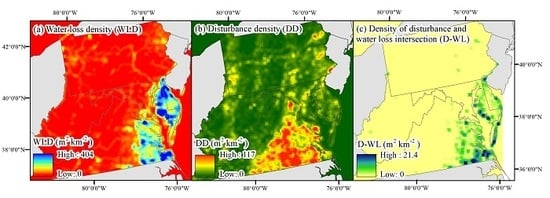Isolating Anthropogenic Wetland Loss by Concurrently Tracking Inundation and Land Cover Disturbance across the Mid-Atlantic Region, U.S.
Abstract
1. Introduction
2. Materials and Methods
2.1. Study Area
2.2. Inundation Extent
2.2.1. Single Image Inundation Classification
2.2.2. Annual Inundation Extent
2.3. Disturbed Extent
Classifying Change as Disturbance
2.4. Validation
2.4.1. Validation of Inundation Extent
2.4.2. Validation of Disturbance Extent
2.4.3. Validation of Water Fill
2.5. Ancillary Datasets
3. Results
3.1. Accuracy of Outputs
3.2. Change Analysis
4. Discussion
5. Conclusions
Author Contributions
Funding
Acknowledgments
Conflicts of Interest
Appendix A
| Landsat Path/Row (p/r) | Image Acquisition Date | Disturbed Points (count) | Non-Disturbed Soil Points (count) |
|---|---|---|---|
| p15r31 | 23-Sep-17 | 43 | 669 |
| p15r31 | 21-May-18 | 53 | 670 |
| p15r31 | 8-Jul-18 | 71 | 668 |
| p15r33 | 18-Mar-18 | 100 | 600 |
| p15r33 | 8-Jul-18 | 100 | 599 |
| p15r33 | 12-Oct-18 | 100 | 600 |
| p16r34 | 10-Jun-17 | 48 | 706 |
| p16r34 | 26-Apr-18 | 55 | 707 |
| p16r34 | 4-Nov-18 | 47 | 707 |
| p17r32 | 26-Mar-16 | 73 | 726 |
| p17r32 | 20-Aug-17 | 80 | 730 |
| p17r32 | 11-Nov-18 | 77 | 730 |
| p18r34 | 8-Apr-18 | 66 | 503 |
| p18r34 | 29-Jul-18 | 82 | 514 |
| p18r34 | 17-Oct-18 | 119 | 498 |
| Total | 1114 | 9627 |
| HR Date | Sensor | Date (ETM+) | Path/Row (ETM+) | Date Gap (ETM+) | Date (OLI) | Path/Row (OLI) | Date Gap (OLI) | State | Image |
|---|---|---|---|---|---|---|---|---|---|
| 26-Jan-18 | WV3 | 14-Jan-18 | p14r33 | −12 | 21-Dec-17 | p14r33 | −36 | DE | P1 |
| 6-Apr-15 | WV3 | 12-Apr-15 | p14r33 | 6 | 4-Apr-15 | p14r33 | −2 | DE | P1 |
| 6-Apr-15 | WV3 | 12-Apr-15 | p14r33 | 6 | 4-Apr-15 | p14r33 | −2 | DE | P2 |
| 20-Feb-17 | WV2 | 28-Feb-17 | p14r33 | 8 | 20-Feb-17 | p14r33 | 0 | MD | P6 |
| 19-Feb-19 | WV2 | 25-Feb-19 | p15r33 | 6 | 10-Feb-19 | p14r33 | −9 | MD | P1 |
| 19-Feb-19 | WV2 | 25-Feb-19 | p15r33 | 6 | 10-Feb-19 | p14r33 | −9 | MD | P2 |
| 20-Oct-17 | WV3 | 17-Oct-17 | p15r33 | −3 | 25-Oct-17 | p15r33 | 5 | MD | P1 |
| 20-Jan-18 | WV3 | 14-Jan-18 | p14r33 | −6 | 28-Dec-17 | p15r33 | −23 | MD | P3 |
| 20-Jan-18 | WV3 | 14-Jan-18 | p14r33 | −6 | 28-Dec-17 | p15r33 | −23 | MD | P7 |
| 23-Nov-18 | WV2 | 21-Nov-18 | p15r32 | −2 | 22-Nov-18 | p14r32 | −1 | PA | P1 |
| 23-Nov-18 | WV2 | 14-Nov-18 | p14r32 | −9 | 22-Nov-18 | p14r32 | −1 | PA | P4 |
| 29-Nov-17 | WV2 | 4-Dec-17 | p15r31 | 5 | 25-Oct-17 | p15r31 | −35 | PA | P1 |
| 18-Oct-18 | WV3 | 18-Oct-18 | p17r32 | 0 | 10-Oct-18 | p17r32 | −8 | PA | P3 |
| 18-Oct-18 | WV3 | 18-Oct-18 | p17r32 | 0 | 10-Oct-18 | p17r32 | −8 | PA | P7 |
| 18-Oct-18 | WV3 | 18-Oct-18 | p17r32 | 0 | 10-Oct-18 | p17r32 | −8 | PA | P10 |
| 18-Oct-18 | WV3 | 18-Oct-18 | p17r32 | 0 | 10-Oct-18 | p17r32 | −8 | PA | P13 |
| 17-Aug-17 | WV3 | 23-Aug-17 | p14r32 | 6 | 22-Aug-17 | p15r32 | 5 | PA | P1 |
| 23-Aug-18 | WV2 | 16-Jul-18 | p15r33 | −38 | 9-Aug-18 | p15r33 | −14 | VA | P2 |
| 23-Aug-18 | WV2 | 9-Sep-18 | p15r33 | 17 | 25-Aug-18 | p15r33 | 2 | VA | P4 |
| 23-Aug-18 | WV2 | 16-Jul-18 | p15r33 | −38 | 25-Aug-18 | p15r33 | 2 | VA | P8 |
| 21-Nov-18 | WV2 | 28-Nov-18 | p16r34 | 7 | 4-Nov-18 | p16r34 | −17 | VA | P1 |
| 21-Nov-18 | WV2 | 28-Nov-18 | p16r35 | 7 | 4-Nov-18 | p16r35 | −17 | VA | P4 |
| 9-Mar-17 | WV3 | 16-Mar-17 | p14r34 | 7 | 20-Feb-17 | p14r34 | −17 | VA | P2 |
| 9-Mar-17 | WV3 | 16-Mar-17 | p14r35 | 7 | 20-Feb-17 | p14r35 | −17 | VA | P4 |
| 9-Mar-17 | WV3 | 16-Mar-17 | p14r35 | 7 | 20-Feb-17 | p14r35 | −17 | VA | P6 |
| 4-Oct-18 | WV3 | 29-Oct-18 | p14r34 | 25 | 21-Oct-18 | p14r34 | 17 | VA | P2 |
| 1-Dec-17 | WV3 | 27-Nov-17 | p14r34 | −4 | 26-Nov-17 | p15r34 | −5 | VA | P5 |
| 1-Dec-17 | WV3 | 27-Nov-17 | p14r34 | −4 | 26-Nov-17 | p15r34 | −5 | VA | P7 |
| 20-Oct-17 | WV3 | 31-Oct-17 | p17r34 | 11 | 7-Oct-17 | p17r34 | −13 | WV | P3 |
| 20-Oct-17 | WV3 | 31-Oct-17 | p17r34 | 11 | 7-Oct-17 | p17r34 | −13 | WV | P7 |
| 20-Oct-17 | WV3 | 31-Oct-17 | p17r34 | 11 | 7-Oct-17 | p17r34 | −13 | WV | P10 |
| 20-Nov-17 | WV3 | 31-Oct-17 | p17r33 | −20 | 24-Nov-17 | p17r33 | 4 | WV | P1 |
| Path/Row | Image Date | Disturbed Soil Points | Path/Row | Image Date | Disturbed Soil Points |
|---|---|---|---|---|---|
| p15r31 | 24-Apr-14 | p16r34 | 10-Jun-17 | 162 | |
| p15r31 | 29-May-15 | p16r34 | 19-Oct-18 | 59 | |
| p15r31 | 13-Apr-16 | p17r32 | 6-Apr-14 | ||
| p15r31 | 23-Sep-17 | 41 | p17r32 | 3-Nov-15 | 131 |
| p15r31 | 8-Jul-18 | p17r32 | 5-Nov-16 | 171 | |
| p15r33 | 24-Apr-14 | p17r32 | 24-Nov-17 | 80 | |
| p15r33 | 14-Aug-14 | p17r32 | 11-Nov-18 | 63 | |
| p15r33 | 17-Aug-15 | 150 | p18r34 | 24-Feb-14 | |
| p15r33 | 2-Jul-16 | 247 | p18r34 | 20-Sep-14 | |
| p15r33 | 22-Aug-17 | 172 | p18r34 | 15-Mar-15 | |
| p15r33 | 8-Jul-18 | 167 | p18r34 | 23-Sep-15 | 70 |
| p15r34 | 14-Aug-14 | p18r34 | 18-Apr-16 | 169 | |
| p15r34 | 17-Aug-15 | 156 | p18r34 | 30-Oct-17 | 130 |
| p15r34 | 13-Apr-16 | 98 | p18r34 | 17-Oct-18 | 159 |
| p15r34 | 2-May-17 | 164 | Total | 2015 | 546 |
| p15r34 | 8-Jul-18 | 185 | 2016 | 793 | |
| p16r34 | 8-Oct-14 | 2017 | 749 | ||
| p16r34 | 20-May-15 | 39 | 2018 | 633 | |
| p16r34 | 7-Jul-15 | 2015–2018 | 2711 | ||
| p16r34 | 29-Oct-16 | 98 |
References
- Hansson, L.A.; Brönmark, C.; Nilsson, P.A.; Åbjörnsson, K. Conflicting demands on wetland ecosystem services: Nutrient retention, biodiversity or both? Freshw. Biol. 2005, 50, 705–714. [Google Scholar] [CrossRef]
- Zedler, J.B.; Kercher, S. Wetland resources: Status, trends, ecosystem services, and restorability. Annu. Rev. Environ. Resour. 2005, 30, 39–74. [Google Scholar] [CrossRef]
- Russi, D.; ten Brink, P.; Farmer, A.; Badura, T.; Coates, D.; Förster, J.; Kumar, R.; Davidson, N. The Economics of Ecosystems and Biodiversity for Water and Wetlands; IEEP: London, UK, 2013. [Google Scholar]
- Van Asselen, S.; Verburg, P.H.; Vermaat, J.E.; Janse, J.H. Drivers of wetland conversion: A global meta-analysis. PLoS ONE 2013, 8, e81292. [Google Scholar] [CrossRef] [PubMed]
- Schieder, N.W.; Walters, D.C.; Kirwan, M.L. Massive upland to wetland conversion compensated for historical marsh loss in Chesapeake Bay, USA. Estuar. Coast. 2018, 41, 940–951. [Google Scholar] [CrossRef]
- Ramsar Convention Secretariat. The Ramsar strategic plan 2009–2015, adjusted 2012. Available online: https://www.ramsar.org/sites/default/files/documents/pdf/strat-plan-2009-e-adj.pdf (accessed on 26 March 2020).
- Dixon, M.J.R.; Loh, J.; Davidson, N.C.; Beltrame, C.; Freeman, R.; Walpole, M. Tracking global change in ecosystem area: The Wetland Extent Trends index. Biol. Conserv. 2016, 193, 27–35. [Google Scholar] [CrossRef]
- Zedler, J.B. Compensating for wetland losses in the United States. Int. J. Avian Sci. 2004, 146, 92–100. [Google Scholar] [CrossRef]
- Dahl, T.E. Status and trends of wetlands in the conterminous United States 2004 to 2009. U.S. Department of the Interior, U.S. Fish and Wildlife Service: Washington, DC, USA, 2011; p. 108. [Google Scholar]
- Ozesmi, S.L.; Bauer, M.E. Satellite remote sensing of wetlands. Wetl. Ecol. Manag. 2002, 10, 381–402. [Google Scholar] [CrossRef]
- Rebelo, L.M.; Finlayson, C.M.; Strauch, A.; Rosenqvist, A.; Perennou, C.; Tottrup, C.; Hilarides, L.; Paganini, M.; Wielaard, N.; Siegert, F.; et al. The Use of Earth Observation for Wetland Inventory, Assessment and Monitoring; Ramsar Technical Report No.10; Ramsar Convention Secretariat: Gland, Switzerland, 2018; p. 31. [Google Scholar]
- Dobson, J.E.; Bright, E.A.; Ferguson, R.L.; Field, D.W.; Wood, L.L.; Haddad, K.D.; Iredale III, H.; Jensen, J.R.; Klemas, V.; Orth, R.J.; et al. NOAA Coastal Change Analysis Program (C-CAP): Guidance for Regional Implementation; NOAA Technical Report NMFS; U.S. Department of Commerce: Washington, DC, USA, 1995; p. 92.
- Pekel, J.F.; Cottam, A.; Gorelick, N.; Belward, A.S. High-resolution mapping of global surface water and its long-term changes. Nature 2016, 540, 418–422. [Google Scholar] [CrossRef]
- Jones, J.W. Efficient wetland surface water detection and monitoring via Landsat: Comparison with in situ data from the Everglades Depth Estimation Network. Remote Sens. 2015, 7, 12503–12538. [Google Scholar] [CrossRef]
- Jones, J.W. Improved automated detection of subpixel-scale inundation – Revised Dynamic Surface Water Extent (DSWE) partial surface water tests. Remote Sens. 2019, 11, 374. [Google Scholar] [CrossRef]
- Papa, F.; Prigent, C.; Aires, F.; Jimenez, C.; Rossow, W.B.; Matthews, E. Interannual variability of surface water extent at the global scale, 1993–2004. J.Geophys. Res-Atmos. 2010, 115, 1–17. [Google Scholar] [CrossRef]
- Zhang, M.; Ustin, S.L.; Rejmankova, E.; Sanderson, E.W. Monitoring Pacific coast salt marshes using remote sensing. Ecol. Appl. 1997, 7, 1039–1053. [Google Scholar] [CrossRef]
- Adam, E.; Mutanga, O.; Rugege, D. Multispectral and hyperspectral remote sensing for identification and mapping of wetland vegetation: A review. Wetl. Ecol. Manag. 2010, 18, 281–296. [Google Scholar] [CrossRef]
- Ling, J.E.; Hughes, M.G.; Powell, M.; Cowood, A.L. Building a national wetland inventory: A review and roadmap to move forward. Wetl. Ecol. Manag. 2018, 26, 805–827. [Google Scholar] [CrossRef]
- Klemas, V. Using remote sensing to select and monitor wetland restoration sites: An overview. J. Coast. Res 2013, 29, 958–970. [Google Scholar] [CrossRef]
- Miller, G.; Morris, J.T.; Wang, C. Mapping salt marsh dieback and condition in South Carolina’s North Inlet-Winyah Bay National Estuarine Research Reserve using remote sensing. Aims Environ. Sci. 2017, 4, 677–689. [Google Scholar] [CrossRef]
- Zar, J.H. Biostatistical Analysis, 3rd ed.; Prentice-Hall: Upper Saddle River, NJ, USA, 1996; p. 662. [Google Scholar]
- Houhoulis, P.F.; Michener, W.K. Detecting wetland change: A rule-based approach using NWI and SPOT-XS data. Photogramm. Eng. Remote Sens. 2000, 66, 205–211. [Google Scholar]
- Nielsen, E.M.; Prince, S.D.; Koeln, G.T. Wetland change mapping for the U.S. mid-Atlantic region using an outlier detection technique. Remote Sens. Environ. 2008, 112, 4061–4074. [Google Scholar] [CrossRef]
- Zhu, Z.; Woodcock, C.E. Continuous change detection and classification of land cover using all available Landsat data. Remote Sens. Environ. 2014, 144, 152–171. [Google Scholar] [CrossRef]
- Moisen, G.G.; Meyer, M.C.; Schroeder, T.A.; Liao, X.; Schleeweis, K.G.; Freeman, E.A.; Toney, C. Shape selection in Landsat time series: A tool for monitoring forest dynamics. Glob. Chang. Biol. 2016, 22, 3518–3528. [Google Scholar] [CrossRef]
- White, J.C.; Wulder, M.A.; Hermosilla, T.; Coops, N.C.; Hobart, G.W. A nationwide annual characterization of 25 years of forest disturbance and recovery for Canada using Landsat time series. Remote Sens. Environ. 2017, 194, 303–321. [Google Scholar] [CrossRef]
- Saxena, R.; Watson, L.T.; Wynee, R.H.; Brooks, E.B.; Thomas, V.A.; Zhiqiang, Y.; Kennedy, R.E. Towards a polyalgorithm for land use change detection. Isprs J. Photogramm. 2018, 144, 217–234. [Google Scholar] [CrossRef]
- Brooks, R.P.; Brinson, M.M.; Havens, K.J.; Hershner, C.S.; Rheinhardt, R.D.; Wardrop, D.H.; Whigham, D.F.; Jacobs, A.D.; Rubbo, J.M. Proposed hydrogeomorphic classification for wetlands of the Mid-Atlantic Region, USA. Wetlands 2011, 31, 207–219. [Google Scholar] [CrossRef]
- Vogeler, J.C.; Braaten, J.D.; Slesak, R.A.; Falkowski, M.J. Extracting the full value of the Landsat archive: Inter-sensor harmonization for the mapping of Minnesota forest canopy cover (1973–2015). Remote Sens. Environ. 2018, 209, 363–374. [Google Scholar] [CrossRef]
- Robertson, L.D.; King, D.J.; Davies, C. Assessing land cover change and anthropogenic disturbance in wetlands using vegetation fractions derived from Landsat 5 TM imagery (1984–2010). Wetlands 2015, 35, 1077–1091. [Google Scholar] [CrossRef]
- Halabisky, M.; Moskal, L.M.; Gillespie, A.; Hannam, M. Reconstructing semi-arid wetland surface water dynamics through spectral mixture analysis of a time series of Landsat satellite images (1984–2011). Remote Sens. Environ. 2016, 177, 171–183. [Google Scholar] [CrossRef]
- Kayastha, N.; Thomas, V.; Galbraith, J.; Banskota, A. Monitoring wetland change using inter-annual Landsat time-series data. Wetlands 2012, 32, 1149–1162. [Google Scholar] [CrossRef]
- Fikas, K.C.; Cohen, W.B.; Yang, Z. Landsat-based monitoring of annual wetland change in the Willamette Valley of Oregon, USA from 1972 to 2012. Wetl. Ecol. Manag. 2016, 24, 73–92. [Google Scholar] [CrossRef]
- Xia, H.; Zhao, W.; Li, A.; Bian, J.; Zhang, Z. Subpixel inundation mapping using Landsat-8 OLI and UAV data for a wetland region on the Zoige Plateau, China. Remote Sens. 2017, 9, 31. [Google Scholar] [CrossRef]
- Rover, J.; Wylie, B.K.; Ji, L. A self-trained classification technique for producing 30 m percent water maps from Landsat data. Int. J. Remote Sens. 2010, 31, 2197–2203. [Google Scholar] [CrossRef]
- Vanderhoof, M.K.; Alexander, L.C.; Todd, M.J. Temporal and spatial patterns of wetland extent influence variability of surface water connectivity in the Prairie Pothole Region, United States. Landsc. Ecol. 2016, 31, 805–824. [Google Scholar] [CrossRef]
- DeVries, B.; Huang, C.; Lang, M.; Jones, J.; Huang, W.; Creed, I.; Carroll, M. Automated quantification of surface water inundation in wetlands using optical satellite imagery. Remote Sens. 2017, 9, 807. [Google Scholar] [CrossRef]
- Cooley, S.W.; Smith, L.C.; Stepan, L.; Mascaro, J. Tracking dynamic northern surface water changes with high-frequency Planet CubeSat imagery. Remote Sens. 2017, 9, 1306. [Google Scholar] [CrossRef]
- Kordelas, G.A.; Manakos, I.; Aragonés, D.; Díaz-Delgado, R.; Bustamante, J. Fast and automatic data-driven thresholding for inundation mapping with Sentinel-2 data. Remote Sens. 2018, 10, 910. [Google Scholar] [CrossRef]
- Wu, Q.; Lane, C.R.; Li, X.; Zhao, K.; Zhou, Y.; Clinton, N.; DeVries, B.; Golden, H.E.; Lang, M.W. Integrating LiDAR data and multi-temporal aerial imagery to map wetland inundation dynamics using Google Earth Engine. Remote Sens. Environ. 2019, 228, 1–13. [Google Scholar] [CrossRef]
- Lang, M.W.; Kasischke, E.S.; Prince, S.D.; Pittman, K.W. Assessment of C-band synthetic aperture radar data for mapping and monitoring coastal plain forested wetlands in the Mid-Atlantic Region, U.S.A. Remote Sens. Environ. 2008, 112, 4120–4130. [Google Scholar] [CrossRef]
- Bolanos, S.; Stiff, D.; Brisco, B.; Pietroniro, A. Operational surface water detection and monitoring using Radarsat 2. Remote Sens. 2016, 8, 285. [Google Scholar] [CrossRef]
- Pham-Duc, B.; Prigent, C.; Aires, F. Surface water monitoring within Cambodia and the Vietnamese Mekong Delta over a year, with Sentinel-1 SAR observations. Water 2017, 9, 366. [Google Scholar] [CrossRef]
- Vanderhoof, M.K.; Distler, H.E.; Lang, M.; Alexander, L.C. The influence of data characteristics on detecting wetland/stream surface-water connections in the Delmarva Peninsula, Maryland and Delaware. Wetl. Ecol. Manag. 2018, 26, 63–86. [Google Scholar] [CrossRef]
- Bourgeau-Chavez, L.L.; Kasischke, E.S.; Brunzell, S.M.; Mudd, J.P.; Smith, K.B.; Frick, A.L. Analysis of space-borne SAR data for wetland mapping in Virginia riparian ecosystems. Int. J. Remote Sens. 2001, 22, 3665–3687. [Google Scholar] [CrossRef]
- Lang, M.; McCarty, G.; Oesterling, R. Topographic metrics for improved mapping of forested wetlands. Wetlands 2012, 33, 141–155. [Google Scholar] [CrossRef]
- Huang, C.; Peng, Y.; Lang, M.; Yeo, I.Y.; McCarty, G. Wetland inundation mapping and change monitoring using Landsat and airborne LiDAR data. Remote Sens. Environ. 2014, 141, 231–242. [Google Scholar] [CrossRef]
- Jin, H.; Huang, C.; Lang, M.W.; Yeo, I.Y.; Stehman, S.V. Monitoring of wetland inundation dynamics in the Delmarva Peninsula using Landsat time-series imagery from 1985 to 2011. Remote Sens. Environ. 2017, 190, 26–41. [Google Scholar] [CrossRef]
- Watson, E.B.; Wigand, C.; Davey, E.W.; Andrews, H.M.; Bishop, J.; Raposa, K.B. Wetland loss patterns and inundation-productivity relationships prognosticate widespread salt marsh loss for southern New England. Estuar. Coast. 2017, 40, 662–681. [Google Scholar] [CrossRef]
- Kearney, M.S.; Rogers, A.S.; Townshend, J.R.G.; Rizzo, E.; Stutzer, D.; Stevenson, J.C.; Sundborg, K. Landsat imagery shows decline of coastal marshes in Chesapeake and Delaware Bays. Eos Trans. Am. Geophys. Union 2002, 83, 173–178. [Google Scholar] [CrossRef]
- Koneff, M.D.; Royle, J.A. Modeling wetland change along the United States Atlantic coast. Ecol. Model. 2004, 177, 41–59. [Google Scholar] [CrossRef]
- Clare, S.; Creed, I.F. Tracking wetland loss to improve evidence-based wetland policy learning and decision making. Wetl. Ecol. Manag. 2014, 22, 234–245. [Google Scholar] [CrossRef]
- PRISM Climate Group, Oregon State University. 2020. Available online: http://prism.oregonstate.edu (accessed on 3 January 2020).
- Homer, C.; Dewitx, J.; Yang, L.; Jin, S.; Danielson, P.; Xian, G.; Coulston, J.; Herold, N.; Wickham, J.; Megown, K. Completion of the 2011 National Land Cover Database for the conterminous United States—Representing a decade of land cover change information. Photogramm. Eng. Remote Sens. 2015, 81, 345–354. [Google Scholar]
- U. S. Fish and Wildlife Service (USFWS). National Wetlands Inventory—Version 2—Surface Waters and Wetlands Inventory; U.S. Fish and Wildlife Service: Washington, DC, USA, 2019. Available online: http://www.fws.gov/wetlands/ (accessed on 1 May 2020).
- Tiner, R.W. Wetland Indicators: A Guide to Wetland Identification, Delineation, Classification, and Mapping; Lewis Publishers: Washington, DC, USA, 1999; 418p. [Google Scholar]
- Lins, H.F.; Slack, J.R. Seasonal and regional characteristics of US streamflow trends in the United States from 1940 to 1999. Phys. Geogr. 2005, 26, 489–501. [Google Scholar] [CrossRef]
- Masek, J.G.; Vermote, E.F.; Saleous, N.E.; Wolfe, R.; Hall, F.G.; Huemmrich, K.F.; Gao, F.; Kutler, J.; Lim, T.K. A Landsat surface reflectance dataset for North America, 1990-2000. Ieee Geosci. Remote Sens. Lett. 2006, 3, 68–72. [Google Scholar] [CrossRef]
- Vermote, E.; Justice, C.; Claverie, M.; Franch, B. Preliminary analysis of the performance of the Landsat 8/OLI land surface reflectance product. Remote Sens. Environ. 2016, 185, 46–56. [Google Scholar] [CrossRef] [PubMed]
- Foga, S.; Scaramuzza, P.L.; Guo, S.; Zhu, Z.; Dilley, R.D.; Beckmann, T.; Schmidt, G.L.; Dwyer, J.L.; Hughes, M.J.; Laue, B. Cloud detection algorithm comparison and validation for operational Landsat data products. Remote Sens. Environ. 2017, 194, 379–390. [Google Scholar] [CrossRef]
- Xu, H. Modification of normalised difference water index (NDWI) to enhance open water features in remotely sensed imagery. Int. J. Remote Sens. 2006, 27, 3025–3033. [Google Scholar] [CrossRef]
- Tucker, C.J. Red and photographic infrared linear combinations for monitoring vegetation. Remote Sens. Environ. 1979, 8, 127–150. [Google Scholar] [CrossRef]
- Zhang, F.; Zhang, B.; Li, J.; Shen, Q.; Wu, Y.; Song, Y. Comparative analysis of automatic water identification method based on multispectral remote sensing. Procedia Environ. Sci. 2011, 11, 1482–1487. [Google Scholar]
- Feyisa, G.L.; Melby, H.; Fehsholt, R.; Proud, S.R. Automated Water Extraction Index: A new technique for surface water mapping using Landsat imagery. Remote Sens. Environ. 2014, 140, 23–25. [Google Scholar] [CrossRef]
- Gautam, V.K.; Murugan, P.; Annadurai, M. A New Three Band Index for Identifying Urban Areas Using Satellite Images. Available online: https://www.researchgate.net/publication/315447944_A_New_Three_Band_Index_for_Identifying_Urban_Areas_using_Satellite_Images (accessed on 26 March 2020).
- Jones, J.W. Landsat Dynamic Surface Water Extent (DSWE) Product Guide, Version 2.0, LSDS-1331; Department of the Interior, U.S. Geological Survey: Tucson, AZ, USA, 2018; 21p.
- Farr, T.G.; Rosen, P.A.; Caro, E.; Crippen, R.; Duren, R.; Hensley, S.; Kobrick, M.; Paller, M.; Rodriguez, E.; Roth, L.; et al. The shuttle radar topography mission. Rev. Geophys. 2007, 45, RG2004. [Google Scholar] [CrossRef]
- Omernik, J.M.; Griffith, G.E. Ecoregions of the conterminous United States: Evolution of a hierarchical spatial framework. Environ. Manag. 2014, 54, 1249–1266. [Google Scholar] [CrossRef]
- Wolf, A. Using WorldView 2 Vis-NIR MSI Imagery to Support Land Mapping and Feature Extraction Using Normalized Difference Index Ratios; DigitalGlobe: Longmont, CO, USA, 2010; Unpublished report. [Google Scholar]
- Cohen, W.B.; Yang, Z.; Kennedy, R. Detecting trends in forest disturbance and recovery using yearly Landsat time series: 2. TimeSync – Tools for calibration and validation. Remote Sens. Environ. 2010, 114, 2911–2924. [Google Scholar] [CrossRef]
- Masek, J.G.; Goward, S.N.; Kennedy, R.E.; Cohen, W.B.; Moisen, G.G.; Schleeweis, K.; Huang, C. United States forest disturbance trends observed using Landsat time series. Ecosystems 2013, 16, 1087–1104. [Google Scholar] [CrossRef]
- Hermosilla, T.; Wulder, M.A.; White, J.C.; Coops, N.C.; Hobart, G.W.; Campbell, L.B. Mass data processing of time series Landsat imagery: Pixels to data products for forest monitoring. Int. J. Dig. Earth 2016, 9, 1035–1054. [Google Scholar] [CrossRef]
- Skakun, S.; Vermote, E.F.; Roger, J.-C.; Justice, C.O.; Masek, J.G. Validation of the LaSRC cloud detection algorithm for Landsat 8 images. IEEE J. Sel. Top. Appl. Earth Obs. Remote Sens. 2019, 12, 2439–2446. [Google Scholar] [CrossRef]
- NOAA National Climatic Data Center. Data Tools: 1981–2010 Normals. Available online: http://www.ncdc.noaa.gov/cdo-web/datatools/normals (accessed on 3 January 2020).
- U.S. Geological Survey. National Hydrography Dataset. 2019. Available online: https://www.usgs.gov/core-science-systems/ngp/national-hydrography/access-national-hydrography-products (accessed on 9 January 2020).
- Brody, S.D.; Davis, S.E.; Highfield, W.E.; Bernhardt, S.P. Spatial-temporal analysis of section 404 wetland permitting in Texas and Florida: Thirteen years of impact along the coast. Wetlands 2008, 28, 107–116. [Google Scholar] [CrossRef]
- Sleeter, B.M.; Sohl, T.L.; Loveland, T.R.; Auch, R.F.; Acevedo, W.; Drummond, M.A.; Sayler, K.L.; Stehman, S.V. Land-cover change in the conterminous United States from 1973 to 2000. Glob. Environ. Chang. 2013, 23, 733–748. [Google Scholar] [CrossRef]
- Townsend, P.A.; Helmers, D.P.; Kingdon, C.C.; McNeil, B.E.; de Beurs, K.M.; Eshleman, K.N. Changes in the extent of surface mining and reclamation in the Central Appalachians detected using a 1976-2006 Landsat time series. Remote Sens. Environ. 2009, 113, 62–72. [Google Scholar] [CrossRef]
- Lang, M.; Stedman, S.M.; Nettles, J.; Griffin, R. Coastal watershed forested wetland change and opportunities for enhanced collaboration with the forestry community. Wetlands 2020. [Google Scholar] [CrossRef]
- Gorelick, N.; Hancher, M.; Dixon, M.; Ilyushchenko, S.; Thau, D.; Moore, R. Google Earth Engine: Planetary-scale geospatial analysis for everyone. Remote Sens. Environ. 2017, 202, 18–27. [Google Scholar] [CrossRef]
- Feng, M.; Huang, C.; Channon, S.; Vermote, E.F.; Masek, J.G.; Townshend, J.R. Quality assessment of Landsat surface reflectance products using MODIS data. Comp. Geosci. 2012, 38, 9–22. [Google Scholar] [CrossRef]
- Huang, W.; DeVries, B.; Huang, C.; Lang, M.W.; Jones, J.W.; Creed, I.F.; Carroll, M.L. Automated extraction of surface water extent from Sentinel-1 data. Remote Sens. 2018, 10, 797. [Google Scholar] [CrossRef]
- DeVries, B.; Huang, C.; Armston, J.; Huang, W.; Jones, J.W.; Lang, M.W. Rapid and robust monitoring of flood events using Sentinel-1 and Landsat data on the Google Earth Engine. Remote Sens. Environ. 2020, 240, 111664. [Google Scholar] [CrossRef]
- Rosen, P.A.; Kim, Y.; Kumar, R.; Misra, T.; Bhan, R.; Sagi, V.R. Global persistent SAR sampling with the NASA-ISRO SAR (NISAR) mission. In Proceedings of the 2017 IEEE Radar Conference (RadarConf), Seattle, WA, USA, 8–12 May 2017. [Google Scholar]
- Johansen, K.; Phinn, S.; Taylor, M. Mapping woody vegetation clearing in Queensland, Australia from Landsat imagery using the Google Earth Engine. Remote Sens. Appl. Soc. Environ. 2015, 1, 35–49. [Google Scholar] [CrossRef]
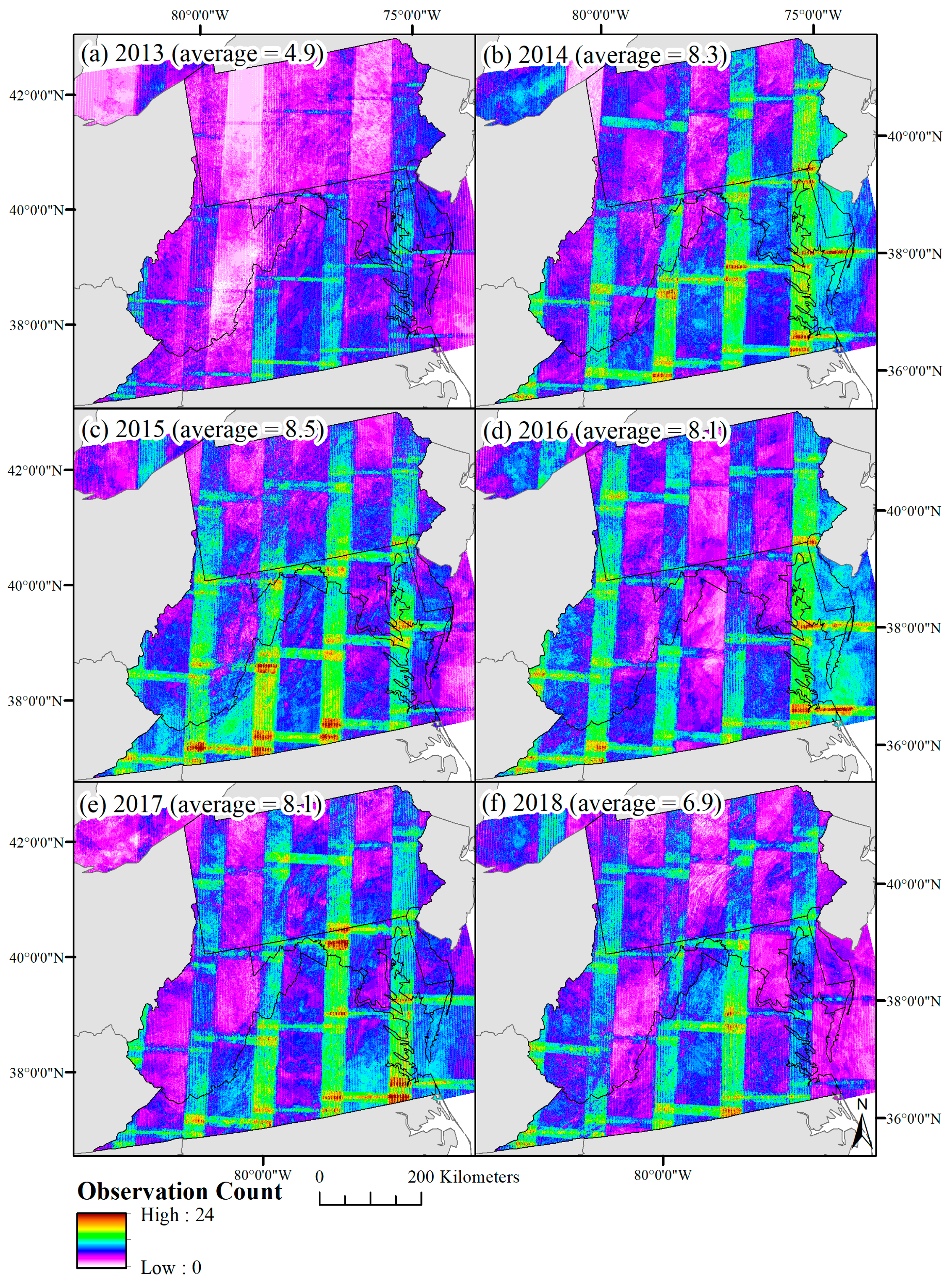


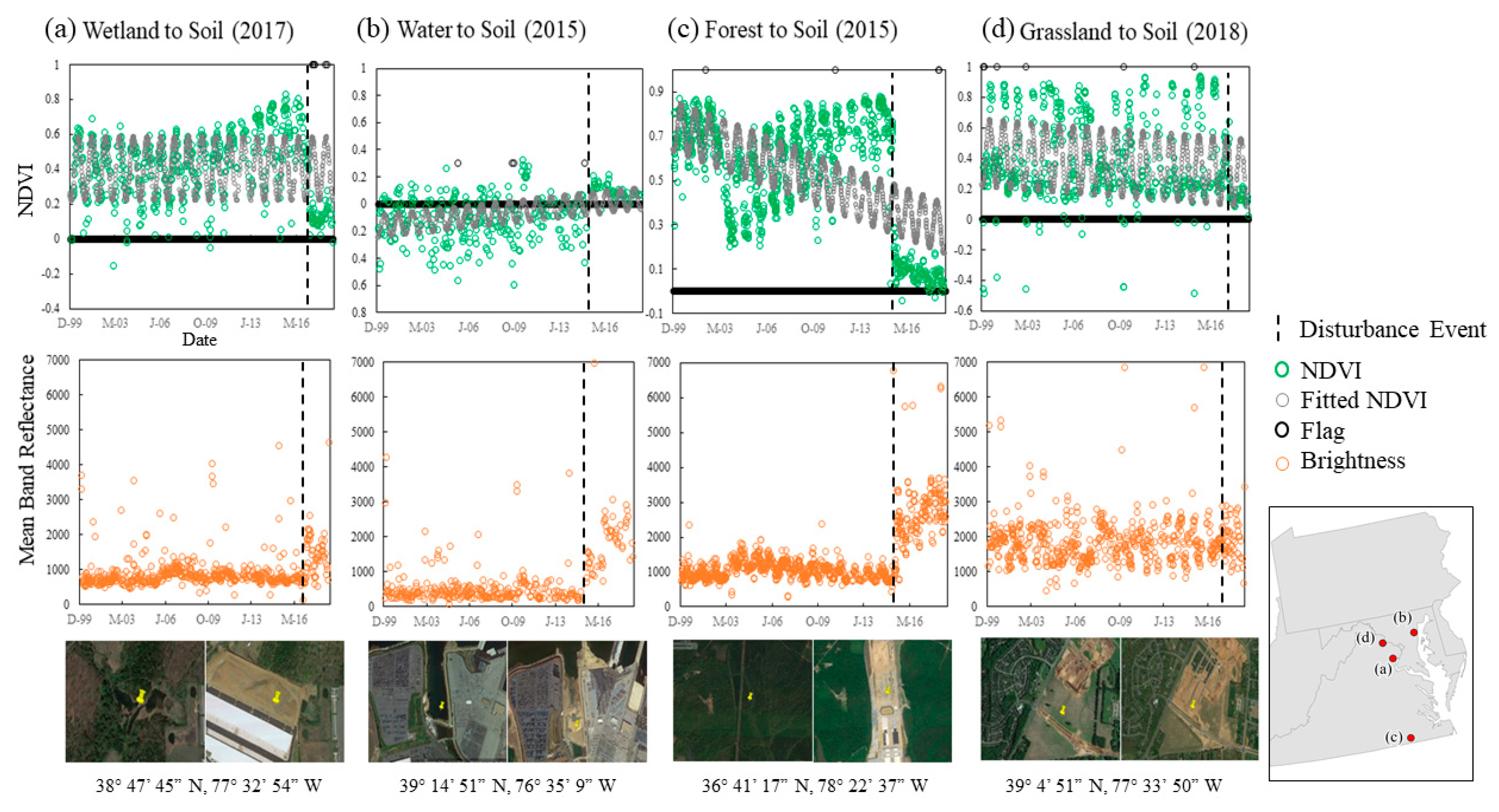
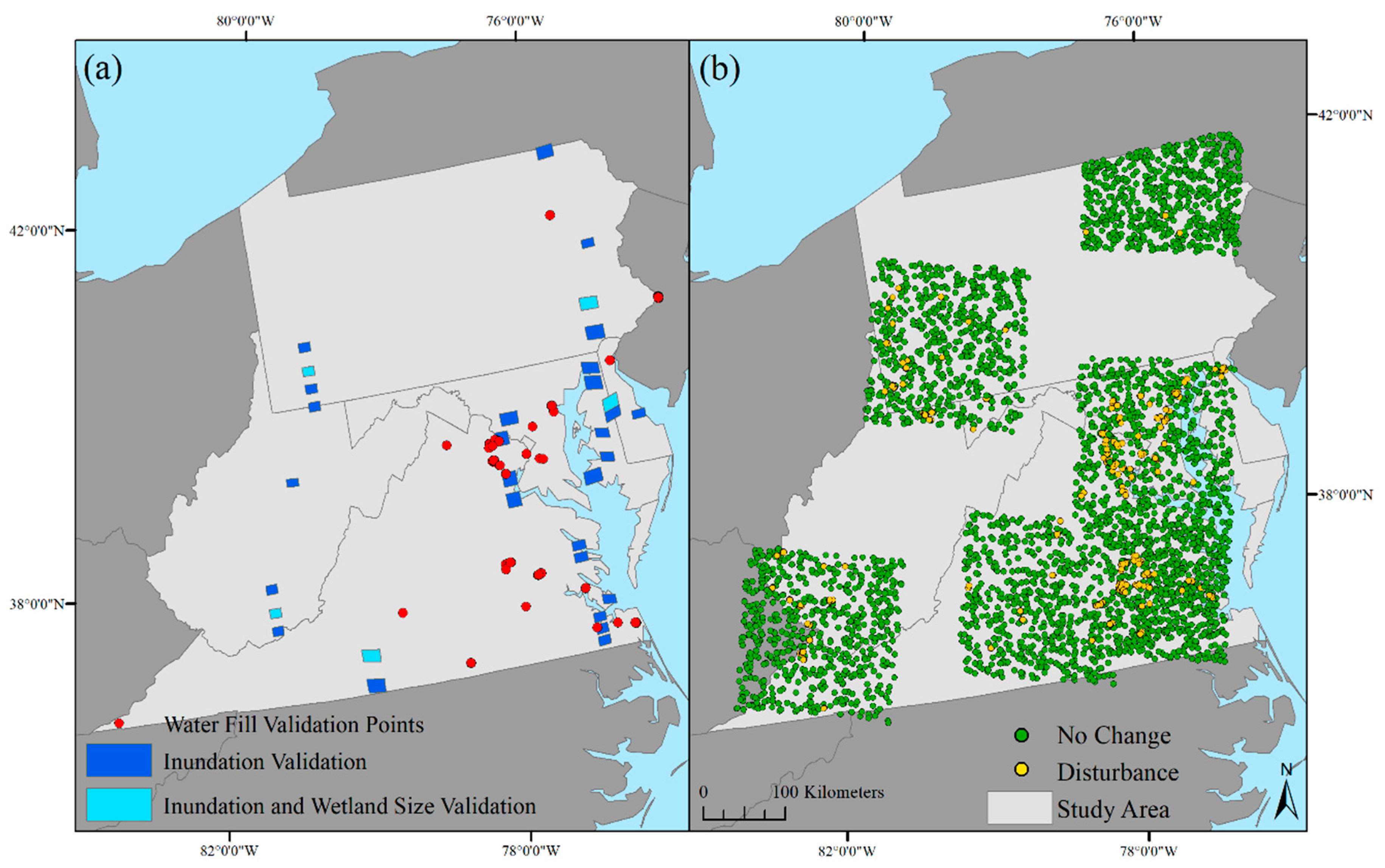

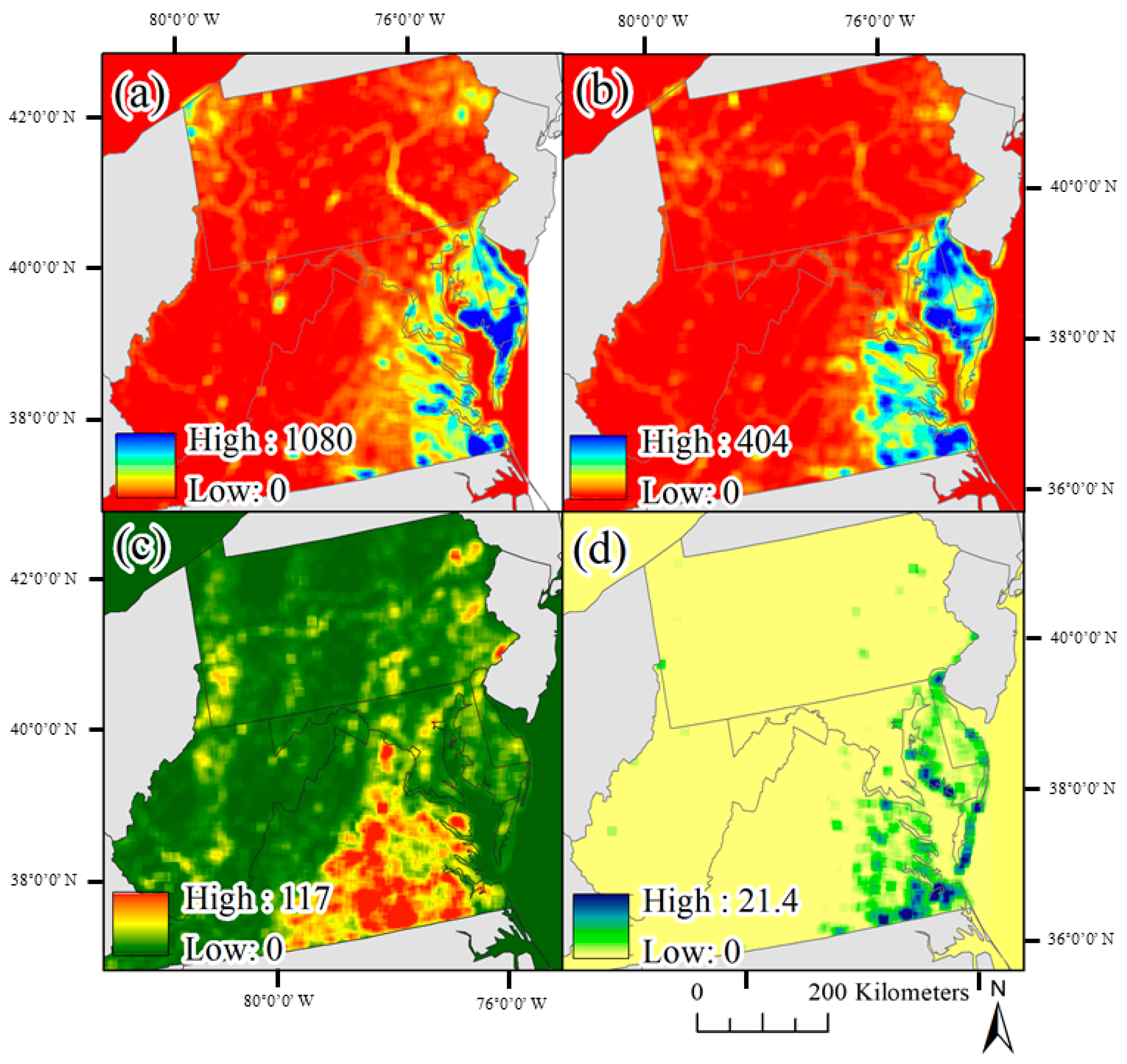
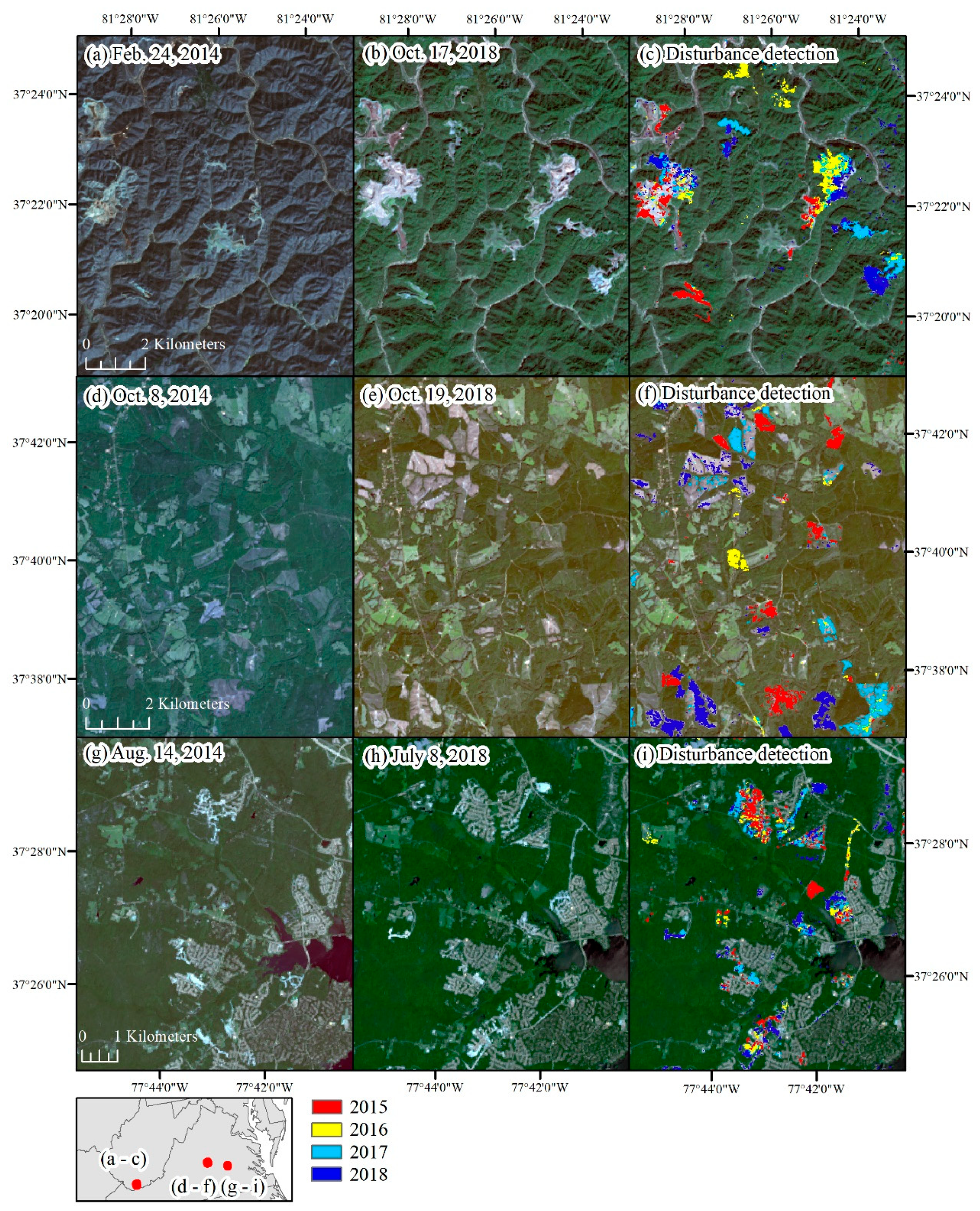
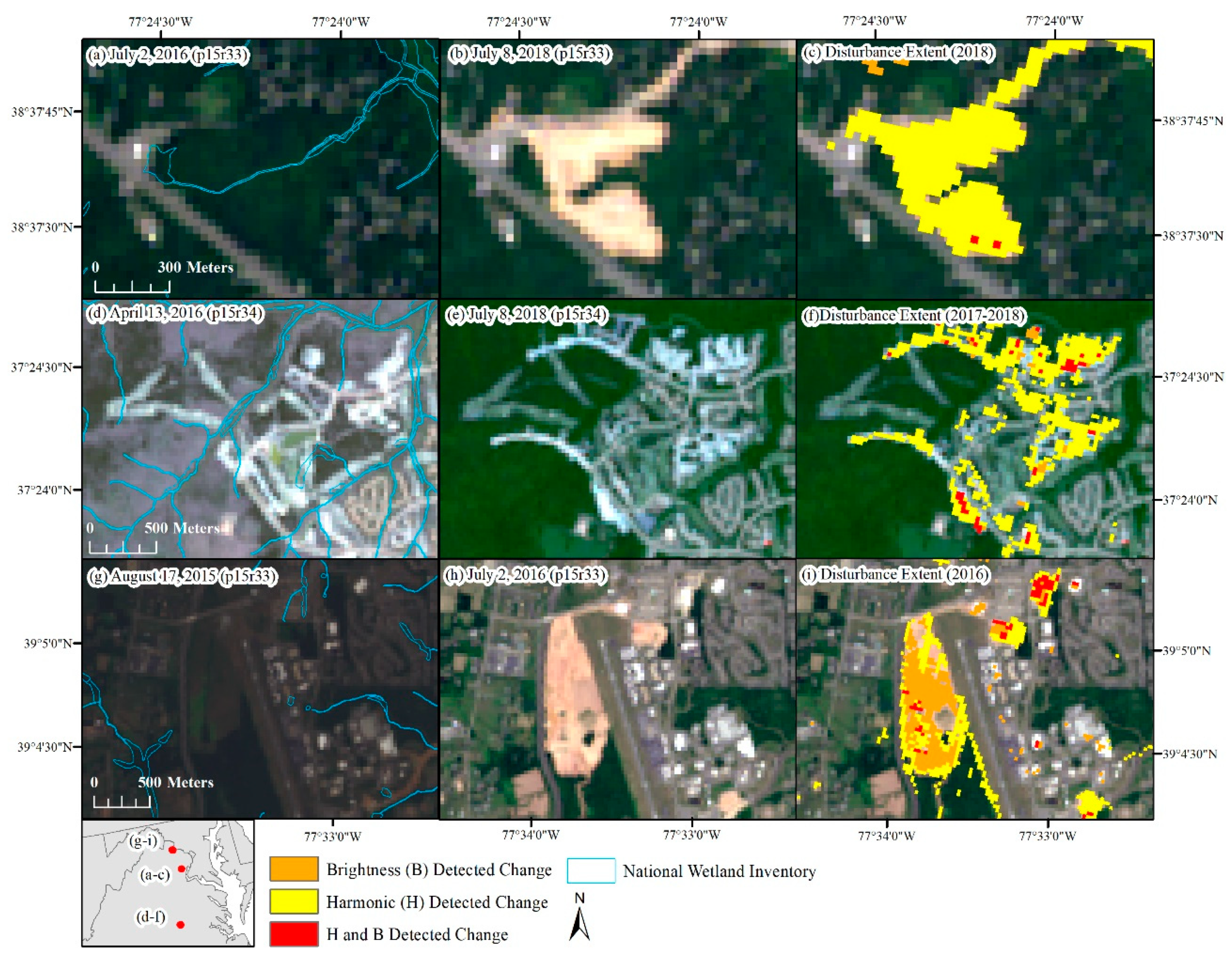
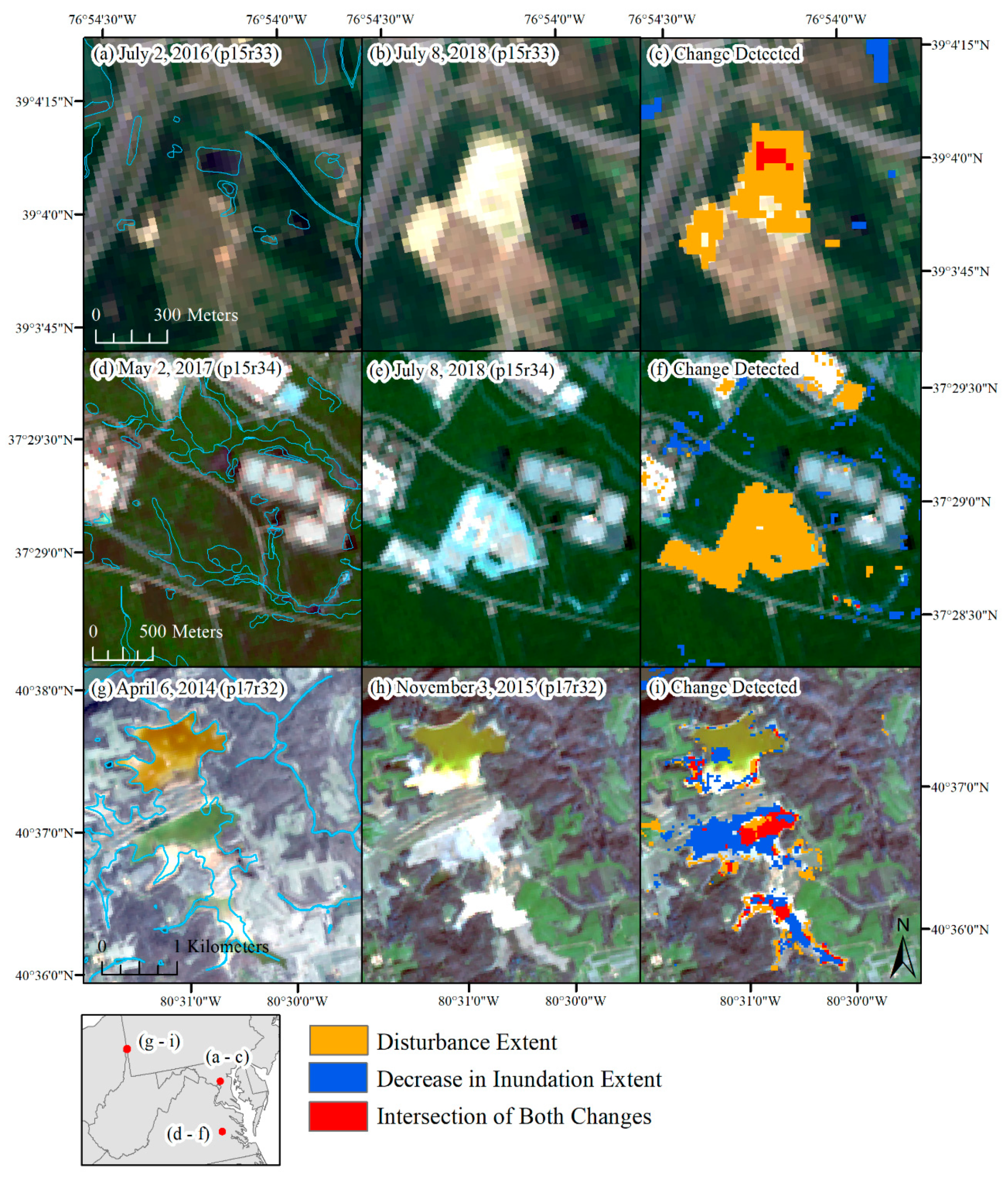
| Algorithm | Imagery Year(s) | Output Year(s) | TM (Image Count) | ETM+ (Image Count) | OLI (Image Count) | Total (Image Count) |
|---|---|---|---|---|---|---|
| Inundation Extent | 2013 | 2013 | ~ | 154 | 85 | 239 |
| Inundation Extent | 2014 | 2014 | ~ | 201 | 189 | 390 |
| Inundation Extent | 2015 | 2015 | ~ | 175 | 205 | 380 |
| Inundation Extent | 2016 | 2016 | ~ | 184 | 203 | 387 |
| Inundation Extent | 2017 | 2017 | ~ | 157 | 221 | 378 |
| Inundation Extent | 2018 | 2018 | ~ | 165 | 183 | 348 |
| Inundation Extent | 2013–2018 | 2013–2018 | ~ | 1036 | 1086 | 2122 |
| Brightness | 2012–2019 | 2015–2018 | ~ | 3673 | 3540 | 7213 |
| Harmonic | 2000–2019 | 2015–2018 | 5037 | 9394 | 3525 | 17,956 |
| Test | Landsat ETM+ | Landsat OLI |
|---|---|---|
| Test 1 | mNDWI > 123 | mNDWI > 123 |
| Test 2 | MBSRV > 0 | MBSRV > 0 |
| Test 3 | AWESH > 0 | AWESH > 0 |
| Test 4 | mNDWI > −400, SWIR1 < 900, NIR < 1500, NDVI < 6000 | mNDWI > −4400, SWIR1 < 900, NIR < 1500, NDVI < 6500 |
| Test 5 | mNDWI > −5000, SWIR1 < 3000, SWIR2 < 1000, NIR < 2500, NDVI < 4000, B < 1000 | mNDWI > −5000, SWIR1 < 3000, SWIR2 < 1000, NIR < 2500, NDVI < 5500, B < 1000, BU3 < 1600 |
| Test 6 | G < 480, NIR < 2500, NDVI < 5500, BU3 < 1600 |
| Landsat ETM | Landsat OLI | ETM-OLI Combined | |||||||
|---|---|---|---|---|---|---|---|---|---|
| Reference – Water | Reference – Upland | Total | Reference – Water | Reference – Upland | Total | Reference – Water | Reference – Upland | Total | |
| Landsat - Water | 6096 | 58 | 6154 | 6027 | 274 | 6301 | 6793 | 294 | 7087 |
| Landsat - Upland | 1292 | 7641 | 8933 | 1383 | 7456 | 8839 | 979 | 7626 | 8605 |
| Total | 7388 | 7699 | 15,087 | 7410 | 7730 | 15,140 | 7772 | 7920 | 15,692 |
| Omission Error (%) | 17.5 | 18.7 | 12.6 | ||||||
| Commission Error (%) | 0.9 | 4.3 | 4.1 | ||||||
| Overall Accuracy (%) | 91.1 | 89.1 | 91.9 | ||||||
| Dice Coefficient (%) | 90.0 | 87.9 | 91.4 | ||||||
| Harmonic Approach | Brightness Approach | B-H Approach | |||||||
|---|---|---|---|---|---|---|---|---|---|
| Reference - D | Reference - UD | Total | Reference - D | Reference - UD | Total | Reference - D | Reference - UD | Total | |
| Landsat - D | 1978 | 49 | 2027 | 1191 | 9 | 1200 | 2290 | 44 | 2334 |
| Landsat - UD | 733 | 3553 | 4286 | 1520 | 3593 | 5113 | 421 | 3558 | 3979 |
| Total | 2711 | 3602 | 6313 | 2711 | 3602 | 6313 | 2711 | 3602 | 6313 |
| Omission Error (%) | 27.0 | 56.1 | 15.5 | ||||||
| Commission Error (%) | 2.4 | 0.8 | 1.9 | ||||||
| Overall Accuracy (%) | 87.6 | 75.8 | 92.6 | ||||||
| Dice Coefficient (%) | 83.5 | 60.9 | 90.8 | ||||||
| Year | PHDI (March-April) | Historical PHDI (%) | Inun. Extent (km2) | Inundation Loss (% of Water) (% of SA) | Disturb. Extent (km2) (% of SA) | Inun. Loss and Disturb. (% of Water Loss) | Inun. Loss – Disturb. Intersect (km2) | NWI – Disturb. Intersect (km2) | NWI – Disturb. (-30 m Buffer) Intersect (km2) |
|---|---|---|---|---|---|---|---|---|---|
| 2013 | 0.24 | 42.7 | 36,881 | ||||||
| 2014 | 1.22 | 57.3 | 38,001 | ||||||
| 2015 | 1.18 | 56.5 | 38,287 | 7.0 (0.80) | 1221.4 (0.35) | 1.12 | 27.6 | 50.1 | 8.2 |
| 2016 | 3.29 | 92.7 | 38,947 | 8.4 (0.99) | 825.1 (0.24) | 0.87 | 25.9 | 34.7 | 6.6 |
| 2017 | 4.15 | 100 | 38,084 | 10.6 (1.21) | 1117.3 (0.32) | 0.85 | 31.9 | 45.4 | 10.8 |
| 2018 | 2.69 | 86.3 | 37,284 | 11.2 (1.25) | 1216.3 (0.35) | 0.58 | 23.3 | 55.5 | 7.8 |
| 2015–2018 | 108.6 | 185.7 | 33.4 |
| NLCD (2013) | Disturbance Distribution (%) | Proportion of Cover Type Disturbed (%) |
|---|---|---|
| Forest | 59.0 | 1.3 |
| Developed (low to high intensity) | 14.1 | 1.6 |
| Hay/Pasture | 8.1 | 0.8 |
| Cultivated Crops | 6.8 | 1.2 |
| Shrub | 4.1 | 2.6 |
| Woody Wetlands | 3.4 | 1.4 |
| Grassland/Herbaceous | 1.7 | 1.4 |
| Barren | 1.5 | 4.2 |
| Open Water | 0.7 | 0.1 |
| Emergent Wetlands | 0.6 | 0.9 |
| Wetland Type | NWI - Disturbance Intersect (km2) | NWI - Disturbance (−30 m buffer) Intersect (km2) |
|---|---|---|
| Freshwater Forested/Shrub Wetland | 115.6 | 27.4 |
| Riverine | 22.0 | 1.2 |
| Freshwater Pond | 11.1 | 0.5 |
| Estuarine and Marine Wetland | 10.2 | 1.4 |
| Lake | 9.8 | 2.6 |
| Freshwater Emergent Wetland | 9.7 | 0.4 |
| Estuarine and Marine Deepwater | 6.5 | 0.3 |
| Other | 0.7 | 0.03 |
© 2020 by the authors. Licensee MDPI, Basel, Switzerland. This article is an open access article distributed under the terms and conditions of the Creative Commons Attribution (CC BY) license (http://creativecommons.org/licenses/by/4.0/).
Share and Cite
Vanderhoof, M.K.; Christensen, J.; Beal, Y.-J.G.; DeVries, B.; Lang, M.W.; Hwang, N.; Mazzarella, C.; Jones, J.W. Isolating Anthropogenic Wetland Loss by Concurrently Tracking Inundation and Land Cover Disturbance across the Mid-Atlantic Region, U.S. Remote Sens. 2020, 12, 1464. https://doi.org/10.3390/rs12091464
Vanderhoof MK, Christensen J, Beal Y-JG, DeVries B, Lang MW, Hwang N, Mazzarella C, Jones JW. Isolating Anthropogenic Wetland Loss by Concurrently Tracking Inundation and Land Cover Disturbance across the Mid-Atlantic Region, U.S. Remote Sensing. 2020; 12(9):1464. https://doi.org/10.3390/rs12091464
Chicago/Turabian StyleVanderhoof, Melanie K., Jay Christensen, Yen-Ju G. Beal, Ben DeVries, Megan W. Lang, Nora Hwang, Christine Mazzarella, and John W. Jones. 2020. "Isolating Anthropogenic Wetland Loss by Concurrently Tracking Inundation and Land Cover Disturbance across the Mid-Atlantic Region, U.S." Remote Sensing 12, no. 9: 1464. https://doi.org/10.3390/rs12091464
APA StyleVanderhoof, M. K., Christensen, J., Beal, Y.-J. G., DeVries, B., Lang, M. W., Hwang, N., Mazzarella, C., & Jones, J. W. (2020). Isolating Anthropogenic Wetland Loss by Concurrently Tracking Inundation and Land Cover Disturbance across the Mid-Atlantic Region, U.S. Remote Sensing, 12(9), 1464. https://doi.org/10.3390/rs12091464





